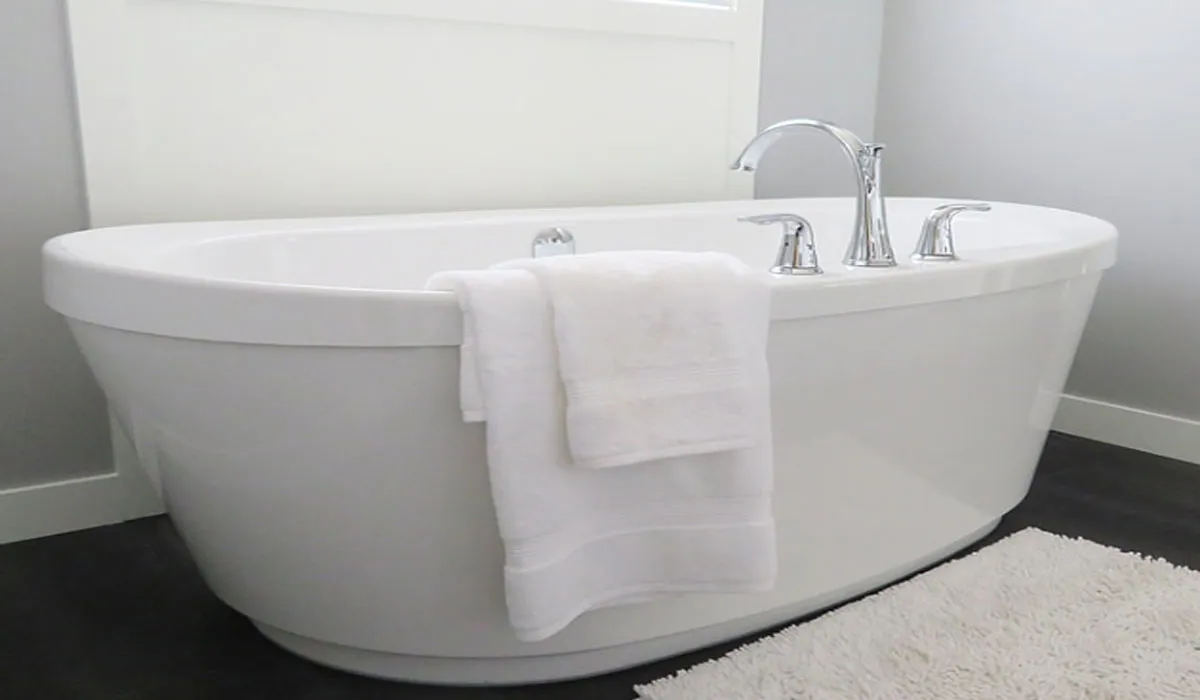Standard bathtubs are typically 30 inches wide, though widths can range from 28 to 36 inches. Bathtub dimensions are key factors when planning a bathroom renovation or selecting the perfect tub for relaxation and comfort.
The width of a bathtub can significantly influence the layout of a bathroom, dictating the amount of floor space available and how the tub will integrate with other fixtures.
Optimal bathtub width not only ensures personal comfort but also contributes to the overall functionality and style of the space.
Whether you’re upgrading an existing bathroom or designing a new one, understanding the typical bathtub sizes available can help streamline the selection process and guarantee a match with your bathroom’s design and user needs.
Remember, the right bathtub width can transform an ordinary bathroom into a haven of tranquility.

Importance Of Bathtub Size
Choosing the right bathtub is crucial for your bathroom’s design and your personal comfort. Size impacts style, functionality, and relaxation quality.
Not all bathtubs fit in every space. Thus, understanding the standard bathtub sizes will help you select the perfect one for your bathroom.
Space Considerations In Bathroom Design
When planning your bathroom, considering the available space is vital. You need to ensure your new bathtub can fit without compromising the rest of your bathroom layout.
- Measure bathroom dimensions before selecting a tub
- Account for clearance around the tub for safety and aesthetics
- Consider door opening space and proximity to other fixtures
| Bathtub Type | Typical Length | Typical Width | Typical Depth |
|---|---|---|---|
| Standard | 60 inches | 30-32 inches | 14-16 inches |
| Freestanding | 55-72 inches | 27-32 inches | 15-20 inches |
| Corner | 60 inches | 60 inches | 14-16 inches |
Comfort And Functionality
Comfort is key when it comes to bathtubs. The dimensions of your tub affect how enjoyable your bath time will be. Here’s what to think about:
- Consider who uses the bathtub. Taller individuals may require longer tubs.
- Depth is important for soaking and relaxation.
- Additional features like armrests and back slopes enhance comfort.
Match the tub size to the users’ needs and the bathroom’s style for a harmonious balance of comfort and design.
Typical Bathtub Dimensions
Choosing the right bathtub size is key to bathroom comfort. Most households prefer standard dimensions that fit well in the average bathroom. Bathtub dimensions vary, but knowing the typical measurements helps in planning your perfect bathroom layout.
Average Lengths And Widths
When it comes to bathtub size, length, and width are crucial. Standard tubs typically measure around 60 inches long and 30 inches wide.
Compact options are great for small spaces, measuring closer to 48 inches long. For a luxurious soak, larger tubs can reach up to 72 inches long. Widths can also vary, with some models going up to 36 inches wide for extra comfort.
Common Depth Measurements
Depth plays a big role in how much water your bathtub can hold. Standard bathtubs have a depth of 14 to 20 inches.
Deeper tubs, known as soakers, go beyond 20 inches, allowing for a more immersive experience. For those who love a good bubble bath, checking the depth is a must.
Typical bathtub dimensions vary, but they generally fall within these ranges:
| Type of Bathtub | Length (inches) | Width (inches) | Depth (inches) |
|---|---|---|---|
| Standard | 60 | 30-32 | 14-20 |
| Compact | 48-60 | 28-32 | 14-20 |
| Large/Soaking | 60-72 | 32-40 | 20+ |
- Compact tubs: Save space in smaller bathrooms.
- Standard tubs: Fit well in most home bathroom layouts.
- Soaking tubs: Offer a deeper water level for a luxurious experience.
Variations Across Bathtub Types
Choosing the perfect bathtub is a key decision in any bathroom renovation or build. With so many designs, materials, and sizes, how wide a bathtub is can vary greatly.
The space available, personal preference, and bathroom layout often dictate the type of tub suitable for your space.
Freestanding Tubs: A Blend Of Styles
Freestanding tubs rise as statement pieces in many modern bathrooms. Their widths can span a broad range, offering flexibility for different spaces.
- Compact designs: 55 inches
- Standard offerings: 60 to 72 inches
- Large luxury models: up to 80 inches or more
Built-in Tubs: The Space-saving Choice
Built-in tubs provide practical, space-saving solutions, often being tucked into bathroom corners or alcoves. These tubs typically come in standardized sizes.
| Type | Standard Width |
|---|---|
| Alcove Tubs | 60 inches |
| Drop-in Tubs | 60 to 72 inches |
| Corner Tubs | 60 to 72 inches, with larger models available |
Remember, built-in tubs often need an extra width for the surrounding deck or enclosure. This adds anywhere from 1 to 4 inches to the overall measurement.

Factors That Influence Bathtub Size
Understanding the factors that influence bathtub size is crucial when selecting the perfect bathtub for your home.
From the physical constraints of your bathroom to personal comfort, various elements play a role in determining what bathtub dimensions will be the best fit. Let’s explore the key factors that dictate the breadth and overall size of your tub.
Bathroom Layout And Size Constraints
The physical dimensions of a bathroom directly impact the size of a bathtub that can be accommodated. Here are some considerations:
- Measure the bathroom’s length, width, and height.
- Consider the placement of existing fixtures.
- Take note of door openings and wall indentations.
- Factor in enough clearance for safe and comfortable use.
Assessing these spatial dimensions ensures the tub fits snugly without obstructing movement.
User Needs And Preferences
Individual preferences and needs shape the ideal bathtub size as well. Reflect on the following:
- User height and body size impact tub depth and length.
- Bathing habits dictate the need for additional features.
- Determine if the tub will be used for soaks or showers too.
- Consider the needs of children, elderly, or those with mobility issues.
Choose a size that aligns with comfort, functionality, and relaxation.
| Factor | Details | Impact |
|---|---|---|
| Bathroom Dimensions | Width, Length, Height | Dictates maximum tub size |
| User Size | Height and Body Size | Influences tub depth and length |
| Bathing Habits | Soaks, Showers | Shapes tub features and design |
Customization And Non-standard Sizes
A typical bathtub might not fit everyone’s needs. Unusual bathroom spaces or specific design visions often require unique solutions.
Customization and non-standard bathtub sizes cater to those who seek a more personalized touch in their bathroom aesthetics and functionality.
When To Consider Custom Bathtubs
Custom bathtubs become significant when standard sizes don’t fit. Think of it in scenarios such as:
- Renovating old homes with unique bathroom layouts.
- Desiring a specific style or shape not available off-the-shelf.
- Requiring accessibility features for enhanced safety and comfort.
It’s about the perfect fit and ultimate personalization.
Pros And Cons Of Going Non-standard
| Pros | Cons |
|---|---|
|
|
Choosing non-standard tubs means weighing the benefits against the drawbacks. Custom bathtubs offer unmatched personalization, ensuring a perfect match with your bathroom layout and style.
Consider the investment not just in terms of money, but also in the satisfaction gleaned from a bathtub crafted just for you.
Installation And Plumbing Considerations
When it’s time for a bathroom upgrade, knowing the width of a bathtub is vital. But beyond the tub’s size, installation and plumbing are key factors that can affect the success of your renovation.
Preparing For A New Bathtub
Before bringing a new bathtub into your space, preparation is crucial. Begin by measuring the bathroom area.
Check that the selected bathtub will fit the desired spot. Allow access for pipes and fixtures. Observe the current plumbing layout. Consider doorways and hallways for getting the tub into the room.
Think about the flooring under the tub, as it will need to support the weight fully. Make a list of all the tools and materials necessary for installation.
Dealing With Plumbing For Different Sizes
Plumbing needs differ for various bathtub sizes. Standard tubs typically measure 60 inches in length, but widths can range from 30 to 42 inches.
Larger or non-standard tubs may need different plumbing configurations. It’s essential to consult a professional for the best outcome.
- Small tubs: Might require less space but check for existing plumbing location.
- Large tubs: Could need additional space and support. Ensure your hot water system can fill the larger volume.
- Freestanding tubs: Offer more flexibility in placement but might need new plumbing lines.
- Whirlpool tubs: Require access to electrical outlets in addition to water lines.
Always remember to turn off the water supply before starting any plumbing work. Double-check the connections for any potential leaks. Adhering to local building codes is crucial for safety and compliance.
FAQs About the Width of Bathtubs
How Wide Is A Standard Bathtub?
A standard bathtub typically measures about 60 inches in width. This dimension allows for comfortable use and easy installation in most bathrooms.
How Much Space Do You Need For A Bathtub?
The space needed for a standard bathtub is about 5 feet in length and 30 to 32 inches in width. Always allow for extra space for installation ease and surrounding movement.
How Wide Are Most Baths?
Most standard baths are about 32 inches (81 centimeters) wide. Some variations are available, catering to different bathroom dimensions and preferences.
What Size Is A Garden Tub?
A standard garden tub typically measures about 60 inches in length and 42 inches in width, with a depth of around 24 inches.
Conclusion
Selecting the right bathtub size enriches bathroom comfort and aesthetics. Typical widths vary, suiting diverse spaces and styles. Before purchasing, consider room dimensions and desired features.
Remember, perfect measurements ensure a seamless renovation or installation. Ready to dive into your bathtub upgrade?
Embrace informed decisions for a blissful soak every time.
Resources:
https://www.cmu.edu/gelfand/lgc-educational-media/succeed/climate-environment-lesson-plans/bathtub-model.html
https://medlineplus.gov/ency/patientinstructions/000154.htm
